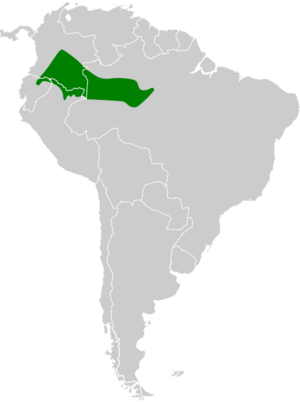White-chinned jacamar facts for kids
Quick facts for kids White-chinned jacamar |
|
|---|---|
 |
|
| Conservation status | |
| Scientific classification | |
| Genus: |
Galbula
|
| Species: |
tombacea
|
 |
|
The white-chinned jacamar (scientific name: Galbula tombacea) is a beautiful, colorful bird. It belongs to a family of birds called Galbulidae, which are known for their long beaks and shiny feathers. You can find these birds living in parts of Brazil, Colombia, Ecuador, and Peru.
Contents
About the White-Chinned Jacamar Family
The white-chinned jacamar is related to several other jacamar species. These include the rufous-tailed, bluish-fronted, coppery-chested, and green-tailed jacamars. Scientists group them together as a "superspecies." This means they are very closely related and likely evolved from a common ancestor.
There are two main types, or subspecies, of the white-chinned jacamar. These are called Galbula tombacea tombacea and G. t. mentalis.
What Does the White-Chinned Jacamar Look Like?
The white-chinned jacamar is a medium-sized bird. It is about 19 to 23.5 centimeters (7.5 to 9.3 inches) long. It weighs around 21.5 to 25 grams (0.76 to 0.88 ounces).
The male Galbula tombacea tombacea has an ash-brown head. The rest of its upper body is a dark, shiny bronzy-green color. It has a small white spot on its chin. Its throat and chest are a sparkly green. The belly and lower area are a reddish-chestnut color.
The female of this subspecies has a paler, more yellowish-brown belly. The other subspecies, G. t. mentalis, has a larger white chin spot. Its upper body feathers are a coppery-bronze color.
Where Do White-Chinned Jacamars Live?
The Galbula tombacea tombacea subspecies lives east of the Andes mountains. You can find it in southeastern Colombia, through Ecuador, and into Peru. It also lives in western Brazil, south of the Amazon River.
The G. t. mentalis subspecies lives further east. It is found along both sides of the Solimões River (which is the upper Amazon River). It extends to where the Solimões meets the Negro River and Madeira River.
These birds like to live in shrubby areas and open spaces. They are found in different types of forests, including terra firme (dry land forest) and várzea (flooded forest). They also live in gallery forest, which are forests along rivers. At lower elevations, they often stay close to water. They can be found up to 1,200 meters (about 3,900 feet) high.
White-Chinned Jacamar Behavior
What Do White-Chinned Jacamars Eat?
White-chinned jacamars mostly eat insects. While they are thought to eat many different kinds of insects, only Hymenoptera (like bees and wasps) have been officially recorded in their diet.
They usually perch alone or in pairs on exposed tree branches. From these spots, they quickly fly out to catch insects in the air. This hunting style is called "sallying."
Reproduction and Life Cycle
Scientists do not have much detailed information about how white-chinned jacamars breed. More research is needed to understand their nesting habits and life cycle.
How Do White-Chinned Jacamars Communicate?
The song of the white-chinned jacamar is a series of "pee-pee-pee" notes. These notes get faster and higher pitched. The song ends with a trill, which is a rapid, vibrating sound. You can hear an example of their song online [1].
Their call sounds like "keelip" or "peeup." They often repeat this call many times in a row [2].
White-Chinned Jacamar Conservation Status
The IUCN (International Union for Conservation of Nature) has evaluated the white-chinned jacamar's status. They have listed it as a species of "Least Concern." This means it is not currently considered to be in danger of extinction.
Even though it lives in a wide area and in some protected places, it is not very common in most areas. Sadly, deforestation (when forests are cut down) continues to reduce the number of these birds. This is a concern for their future.



